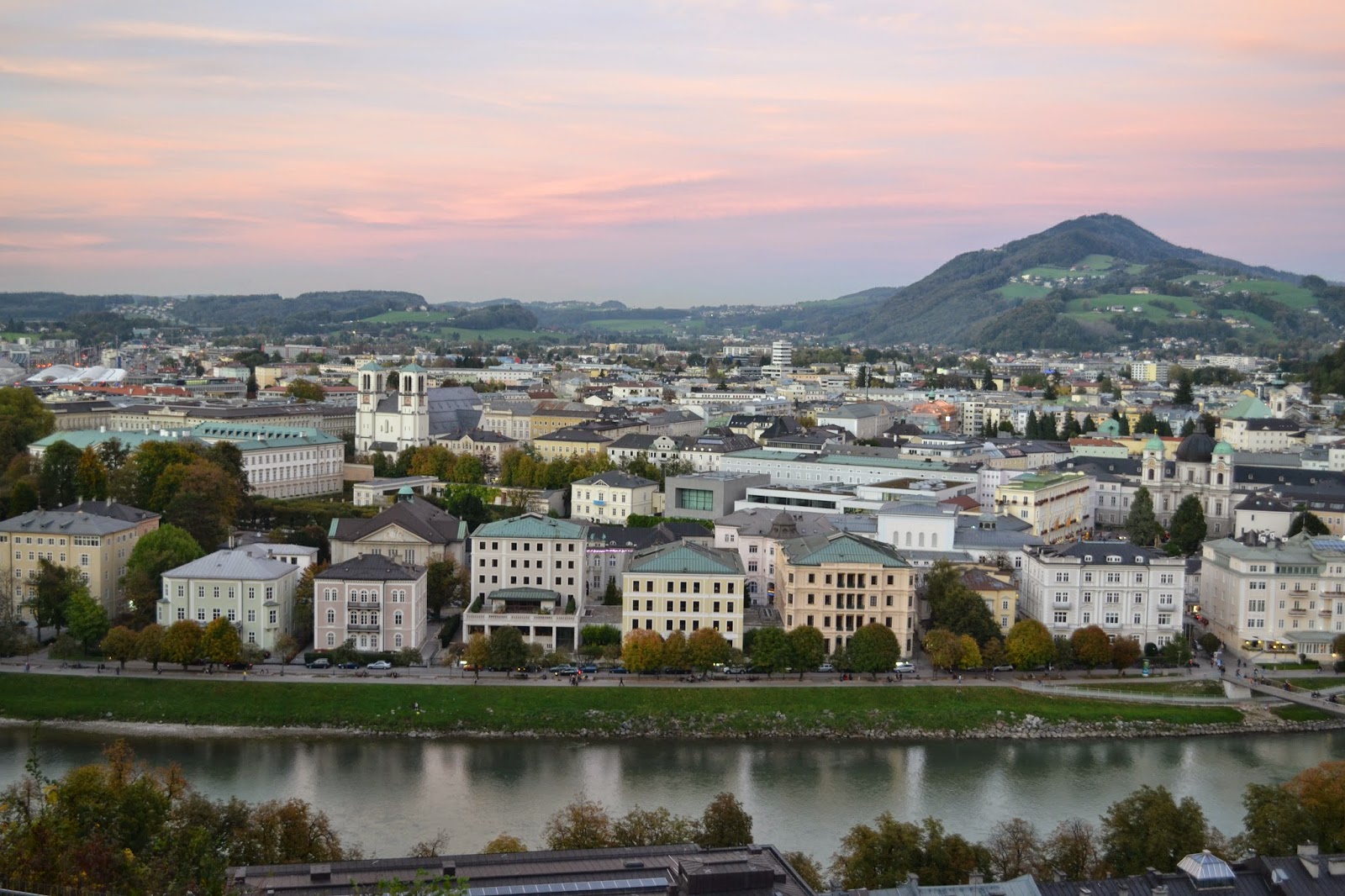October 18, 2014 ---- Salzburg is Mozart's hometown. It's a small city located at the border between Germany and Austria, about 2 hours (on a train) from Munich, so it's worth a day trip if you stay or live in this area. The charming town is full of music, unique church architecture and beautiful landscapes. Even though it isn't part of the German state of Bavaria, you still can use the Bayern ticket to take a local train to Salzburg from any city in Bavaria.
As soon as Nathan and I arrived at Salzburg Hbf station, we went to the Tourist Info and bought
Salzburg Cards. They were € 26 each and allowed us to used any public transportation and visit any tourist sites in the city within 24 hours. (There are 24, 48 and 72 hour cards for your selection.) It was very economical and convenient because we could skip long ticket lines and walk straight into all the places in town.
Nathan and I also followed
Rick Steves's free audio guide in Salzburg. It started at
Mozartstag and
Salzach River, which once was an important pathway for transporting salt. Then we walked to
Mozartplatz where the statue of the town's most famous composer of the Classical era, Wolfgang Amadeus Mozart, is situated. Here was also where
Salzburg Museum was located, and we just paused the audio guide and went in. I didn't really like the museum, but Nathan liked it. I felt like it was a waste of time strolling in a museum that has no significant historical pieces to look for...or maybe I just didn't know what to look for...
Then we restarted our audio guide and walked to
Residenzplatz. There was a beautiful fountain here and we got a view of the New Residence & Carillon (Neue Residenz & Glockenspiel). Next to Residenzplatz is
Domplatz where
The Cathedral located. It was one of the most beautiful churches I have ever seen. I especially liked the plain white plaster carving on the ceiling and the layout of the church. At the entrance of the Cathedral to the right was the entrance to
Domquartier of Salzburg. It's a huge complex including the Residence, the Residence Gallery, the Residence State Rooms, the terrace under the Cathedral Arches, northern oratorio, Cathedral organ loft, Cathedral Museum, Art and Rarities Collection, the Long Gallery, St. Peter's Museum, and View of the Franciscan Church Choir. As a result, you should plan to spend at least 2-3 hours in there.
Next we went to
Kapitelplatz or Chapter Square where we saw many sales booths, people playing chess and the "Sphaera," a work of art by Stephan Balkenhol. Then Nathan and I paused the audio guide and took a cable car up to
Hohensalzburg Fortress, Central Europe's largest completely preserved fortress dating from the 11th century. Here we not only got the best view of Salzburg, but also got to learned about the fortress at the
Fortress Museum and the
Tour of the State Rooms with free audio guide. It's definitely the most important tourist attraction in the city!
After spending a lot of time at the fortress, I was afraid that we won't make it to Mozart's Birthplace and Mozart's Residence by the time they closed, so we just stopped Rick Steves's audio guide and walked straight to
Mozart's Birthplace. It was the place where Mozart was born in 1756, and the house had documents and portraits of the Mozart family and some musical instruments. Then we walked across the river to
Mozart's Residence where the Mozart family lived during 1773-1780.
Mirabellgarten is also one of the major tourist attractions in Salzburg. If you ever see a photo of Salzburg, it's usually a photo of Mirabellgarten. After taking a little rest here, Nathan and I walked back to
St. Peter Cemetery and resumed Rick Steves's audio guide. The cemetery was the loveliest one I have ever seen. On every single grave was a small flower garden, and the cobblestone street and the Margarethenkapelle (
Margaret Chapel) made the cemetery lovely. We also went inside St. Peter's Church.
Then we continued to Toscaninihof. There was a staircase up to Mönchsberg Hill where we got a good view of Salzburg, but there were other places you can get a better view without climbing stair steps. The audio guide later took us to Universitätsplatz, but the farmers' market was already gone and it was almost dark. We peeked into Kollegienkirche or the University of Salzburg Church a little bit and found that it must have recently been renovated because the entire wall was pastry white.
Last but not least, we took Mönchsberg lift up to the Museum of Modern Art. However, we didn't really want to visit the museum, but just to get a good view of Salzburg while the sun was setting. There was a really nice restaurant with a panoramic view of the city up there.
After a full day of sightseeing, we went to dinner at one of the local restaurants on Getreidegasse street. The food was good and plentiful, but I still think that Germanic food is boring....only one taste--salty.
Mozartstag and Salzach River
Mozartplatz
Salzburg Museum
Residenzplatz
Domplatz
The Cathedral
Domquartier of Salzburg
The Residence
Kapitelplatz
The view from Hohensalzburg Fortress
Mozart's Birthplace
Mozart's Residence
Mirabellgarten
Makartsteg
St. Peter Cemetery
St. Peter's Church
Toscaninihof
Kollegienkirche
The view from Mönchsberg
Getreidegasse



















































































